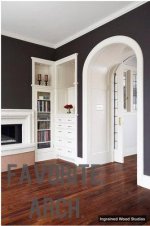rnt80
Member
- Joined
- Mar 30, 2008
- Messages
- 953
I have to bid out some trim work that will involve a paneled archway. I was planning on using some composite, flexible moulding material for the rails and stiles but, without paying for new moulds to be cast, my supplier only has applied moulding available which is something the customer is not interested in. The opening is approximately 4' wide. Would I be able to profile some 3/4" mdf with a cope and stick door set and then cut kerfs in the back to make it flexible enough to conform to the archway? Any other suggestions on how to tackle this?

